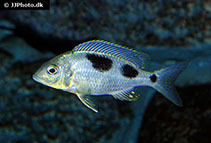| Family: |
Cichlidae (Cichlids), subfamily: Pseudocrenilabrinae |
| Max. size: |
13.9 cm TL (male/unsexed) |
| Environment: |
benthopelagic; freshwater; depth range 2 - 65 m |
| Distribution: |
Africa: Endemic to Lake Malawi. Occurs in the south and north ends of the lake. |
| Diagnosis: |
Dorsal spines (total): 15-17; Dorsal soft rays (total): 10-13; Anal spines: 3-3; Anal soft rays: 9-10. Diagnosis: low number of gill-rakers (15-18) (Ref. 55925).
Description: relatively elongate; outer teeth mostly bicuspid, in lower jaw somewhat procumbently implanted; only largest specimens with significant number of unicuspid teeth, especially in lateral parts of upper jaw; inner teeth of oral jaw tricuspid, obtuse rather than fine and acute; 3-5 series of scales on cheek; lower pharyngeal jaw relatively wide and delicate, with all teeth slender and acute, none of them enlarged and some recurved; gill-rakers not as close-set as in congenerics, but still elongate and not ramified; 22-29 scales in upper part of lateral line, 12-17 in lower part; (3)5-8 scales between pectoral and pelvic fins (Ref. 55925).
Coloration: Live: arrangement of spots as in preserved specimens (Ref. 55925). Adult territorial males of short-spotted form: general color blue; ventral and ventro-lateral parts of head and body yellow, probably darker in highly territorial males; anterior part of body scales yellow, posterior part blue, with the amount of yellow becoming greater towards the ventral part of the body; pectoral fins greyish; pelvic fins black with white leading edge; dorsal and caudal fins greyish blue with yellow-brown maculae and striae; dorsal fin with yellow lappets and white submarginal band; proximal part of anal fin dark, distal part yellowish with yellow ocelli (Ref. 55925). Females of short-spotted form: silvery with bronze hue on dorsal and dorso-lateral parts of head and body, but with yellow ventro-lateral and ventral parts, in particular on head and belly; region between pelvic and anal fins silvery; anterior part of body scales yellow, posterior part silvery, with the amount of yellow becoming greater towards the ventral and ventro-lateral parts of the body; dorsal and caudal fins yellowish grey with brown maculae and striae; pale-yellow dorsal fin lappets; anal fin yellow anteriorly and whitish transparent with pale yellow spots posteriorly; pectoral fins transparent with yellowish hue; pelvic fins yellow with white leading edge (Ref. 55925). Color pattern of immature and non-territorial males of the short-spotted form intermediate between female and adult male pattern, with an increasing intensity of blue with increasing territoriality (Ref. 55925). Non-territorial males of elongate-spotted form: body silvery with a blue hue and some yellow pigment on ventral and lateral part of head and anterior part of body; fins slightly yellowish; dorsal fin with orange-yellow lappets and white submarginal band; dorsal and caudal fins with regular pattern of yellow-brown maculae and striae; anal fin with orange-yellow ocelli (Ref. 55925). Females and immature males of elongate-spotted form similar to short-spotted form but with appreciably less yellow pigment (Ref. 55925). Preserved: species with three spots of variable shape on the body, allowing to discern a short-spotted form and an elongate-spotted form, the latter with a melanin pattern that rather looks like an interrupted line than a series of blotches, due to an elongated suprapectoral and supra-anal spot; suprapectoral spot on upper part of lateral line; supra-anal spot below posterior part of dorsal fin, between upper and lower lateral line; major part of the caudal spot situated on the upper part of the caudal peduncle (Ref. 55925). Adult territorial males: yellow-brown to dark brown, darker on dorsal parts; branchiostegal memebranes and ventral part of body anterior to pelvic fins black; dorsal fin dark brown with dark maculae and white lappets; caudal fin dark brown with indistinct dark maculae; pelvic and anal fins dark brown to black; anal fin with white ventral edge; pectoral fins whitish (Ref. 55925). Juveniles, females and non-territorial males: body brown yellowish; all fins brownish yellow; dorsal and caudal fins with dark maculae; traces of vertical bars can only be seen in juveniles (Ref. 55925). |
| Biology: |
Occurs in shallower part of the sandy shores but also found at levels below 30m (Ref. 5595), and frequents muddy/soft bottoms (Ref. 5595, 55925), but also found over rocky habitat (Ref. 55925). Feeds mainly on small benthic invertebrates (Ref. 267). Scoops up large amounts of silty sediment from the sand; commonly observed in small groups of about 5 individuals, but also forages in large schools (Ref. 55925). |
| IUCN Red List Status: |
Least Concern (LC); Date assessed: 22 June 2018 Ref. (130435)
|
| Threat to humans: |
harmless |
Source and more info: www.fishbase.org. For personal, classroom, and other internal use only. Not for publication.

